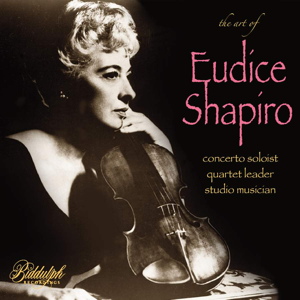
Eudice Shapiro (violin)
The Art of Eudice Shapiro – Concerto Soloist, Quartet Leader, Studio Musician
rec. 1944-1958
Biddulph 85025-2 [77]
A native of Buffalo, New York, Eudice Shapiro (1914-2007) was a student of Gustave Tinlot (Eastman School of Music) and Efrem Zimbalist (Curtis Institute) who primarily made her name as a prized concertmaster and quartet leader on the West Coast in the mid-20th century. She was the first woman to ever serve as the concertmaster of a major film studio orchestra, taking the first chair of the RKO Studio Orchestra in 1942; her luscious solos can be heard on the soundtrack of films like The Lost Weekend (1945) and Love is a Many-Splendored Thing (1955). Shapiro later taught several generations of young violinists at the University of Southern California, where she often played chamber music with her colleague Jascha Heifetz. She premiered many modern works by Lou Harrison, Ingolf Dahl, and William Schuman, among others, and was a favorite interpreter of Stravinsky’s. This new disc includes her only concerto recording, a 1944 reading of the Mozart Concerto no. 5 with Franck Black and the NBC Symphony; a set of short works with the American Art Quartet originally released on RCA Victor’s budget Bluebird label in the early 1950s; and two solos by Hollywood composer Victor Young.
Shapiro’s recording of the Mozart concerto would be considered a fine performance heard once over the radio, but on repeated listening it does not hold up to scrutiny. Although the booklet notes author Wayne Kiley writes admiringly of her “robust, full-bodied treatment” of the Mozart, her sound is often forced and over-pressurized, the result being a repeated flaring in the tone at the beginning of a bow stroke. There are many small problems with intonation, and the violinist plays a number of slurpy portamenti that are emphatically unidiomatic, especially when paired with her aggressive sound production. She is at her best in the first movement cadenza by Joachim. The lack of orchestra backing seems to put her at ease; she plays more naturally here with a significantly lighter tone, and her negotiation of Joachim’s technical hurdles is impressive.
The violinist’s playing in the quartet pieces possesses all the strengths heard in the Mozart cadenza with none of the weaknesses. When not menaced by an overbearing orchestral accompaniment, Shapiro’s basic sound has a pleasing quicksilver quality that explains her busy career as a Hollywood musician; one can easily imagine the warm but intense coloring on display here backing up a love scene or tensely emotional moment. Shapiro channels both Kreisler and Heifetz in the famous Andante cantabile from Tchaikovsky’s String Quartet op. 11, alternately adopting their trademark styles of portamento. What a pleasure to hear the Wolf Italian Serenade played with just the right combination of élan and poetry! Most modern recordings seem to focus solely on forward motion, with little of the humor or elegance found by the American Art Quartet. Joaquín Turina’s La Oración del torero is typical of that composer, offering up a Technicolor Iberian soundscape that is enjoyable without being particularly memorable. Percy Grainger must have been pleased by this performance of his Molly on the Shore, which is played with gusto.
The two tunes by Victor Young place Shapiro alongside Toscha Seidel and Louis Kaufman as a supreme performer of Hollywood violin fare. (Seidel’s solos in Shane and Kaufman’s in Gone with the Wind are among the greatest examples of cinematic violin playing.) Shapiro’s timing and detailed articulation has a speech-like quality to it, particularly in “Je vous adore.” (“Stella by Starlight” sounds as if it was recorded in a bathroom, with Shapiro in the tub behind the curtain.) I hope that someone will find a way to collect some of her film solos in one spot, given the high quality of her playing in this repertoire.
Richard Masters
Help us financially by purchasing from


Contents
Wolfgang Amadeus Mozart (1756-1791)
Violin Concerto No.5 in A, K.219 (1775)
NBC Symphony Orchestra/Frank Black
rec. August 1944, live by AFRS
Felix Mendelssohn (1809-1847)
Scherzo from String Quartet in E minor (1837 rev 1839)
Pyotr Ilyich Tchaikovsky (1840-1893)
Andante cantabile from String Quartet in D Major, Op.11 (1871)
Hugo Wolf (1860-1903)
Italian Serenade in G major (1887)
Gabriel Fauré (1845-1924)
Après un rêve, Op. 7 No. 1 (1878) arr. Jaffe
Joaquín Turina (1882-1949)
La Oración del torero, Op. 34 (1925)
Sergei Rachmaninoff (1873-1943)
Serenade in B-flat Minor, op. 3 no. 5 (1892) arr. Hartman
Dmitri Shostakovich (1906-1975)
Polka from “The Age of Gold” (1930)
Frank Bridge (1879-1941)
An Irish Melody “Londonderry Air” (1908)
Percy Grainger (1882-1961)
Molly on the Shore (1907)
American Art Quartet
rec. September 1953, on RCA Victor Bluebird
Victor Young (1899-1956)
Je vous adore (c. 1936)
Stella by Starlight (1944)
Paul Weston and his Orchestra
rec. 1958, on Columbia


















